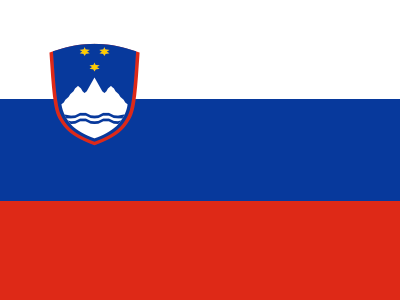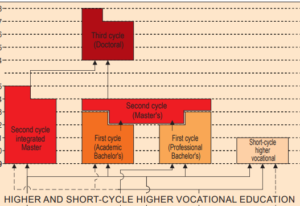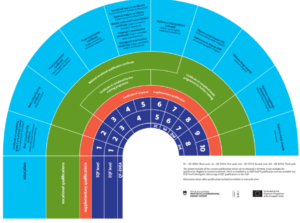
Slovenia
Last updated in 2021
Chapter 1: Higher Education System
Section 1.1.: Schematic Description of the Higher Education System
Section 1.2: Description of Higher Education System
Higher education is set in accordance with the Bologna Declaration. First cycle study programmes are academic and professional study programmes; they last three to four years and consist of 180 to 240 credits (ECTS). Second cycle study programmes are master’s study programmes. They consist of 60 to 120 credits (ECTS) and last one to two years. Second cycle study programmes also include integrated master’s study programmes, which last five to six years and consist of 300 to 360 credits (ECTS). Doctoral study programmes are third cycle programmes; they last three to four years and consist of 180 to 240 credits (ECTS).
Higher education institutions are either public or private. All institutions, except professional colleges, may provide first, second and third cycle study programmes. Professional colleges may provide, as a rule, first-cycle professional study programmes, but also second-cycle programmes if they have suitable higher education teachers, researchers and higher education associates and they comply with the conditions for the performance of scientific research or artistic work.
Section 1.3: Number of Higher Education Institutions
103 HEIs are accredited in the academic year 2019/2020 in Slovenia.
By type of HEI, Slovenia has 6 (3 public, 3 private) universities with 59 faculties and 4 academies, as well as 39 (1 public, 38 private) independent HEIs, of which 20 are faculties, 17 professional colleges and 2 academies. Also, the Euro-Mediterranean University (EMUNI), an international association of universities, is having its seat in Slovenia.
Section 1.4 Number of Students in Higher Education
| Enrolled on October 30 | |||||||||
| 2019/2020 | I. | II. | III. | Sum | |||||
| Universities | 35.953 | 19.538 | 2.863 | 58.354 | |||||
| EMUNI | 6 | 6 | |||||||
| Independent HEIs | 6.105 | 1.445 | 446 | 7.996 | |||||
| Sum | 42.058 | 20.989 | 3.309 | 66.356 | |||||
|
Foreign students in 2019/2020 |
|||||||||
| I. | II. | III. | Sum | ||||||
| full-time | 3.019 | 1.736 | 179 | 4.934 | |||||
| part-time | 745 | 342 | 507 | 1.083 | |||||
| Sum | 3.764 | 2.078 | 686 | 6.017 | |||||
Section 1.5: Structure of Academic Year
According to Article 37 of the Higher Education Act, the academic year shall run from 1 October to 30 September. The academic year commonly includes two semesters of 15 working weeks each, and three periods of examination (June-July, September, January-February). Holidays are in July, August and September.
In addition, the undergraduate study programmes shall comprise of at least 20 and at most 30 hours of lectures, seminars and practical exercises per week and of 30 weeks per year. If a study programme contains practical training, the total student workload may not exceed 40 hours per week or 42 weeks per year.
Any further detailed rules and procedures concerning the academic calendar, examination procedure, completion of education, organisation and schedule of lectures, seminars and practical exercises may be adapted to the possibilities of the students (e.g. part-time studies, art academies courses) shall be regulated in the statutes of individual higher education institutions (Article 66). http://www.pisrs.si/Pis.web/pregledPredpisa?id=ZAKO172
Section 1.6: National Qualifications Framework (or Similar)
The Slovenian Qualifications Framework Act (Official Gazette of the Republic of Slovenia, No. 104/15) established a unified system and classification of qualifications acquired by education and which are organised into certain levels. Levels in the Slovenian Qualifications Framework (SQF) are incorporated into the European Qualifications Framework (EQF) and into the Qualifications Framework for the European Higher Education Area (QF-EHEA).
http://www.pisrs.si/Pis.web/pregledPredpisa?id=ZAKO6958
Qualifications in the SQF, EQF and QF-EHEA are classified as presented in the following table.
| Qualifications | SQF level | EQF level | QF-EHEA level | |
| Diploma prve stopnje (VS)
(Professional bachelor’s degree) Diploma prve stopnje (UN) (Academic bachelor’s degree) |
7 | 6 | First cycle | |
| Diploma druge stopnje
(Master’s degree and long-cycle master’s degree) |
8 | 7 | Second cycle | |
| Diploma tretje stopnje
(Doctorate) |
10 | 8 | Third cycle |
https://www.nok.si/en/about-sok
Section 1.7: Learning Outcomes in Higher Education
The Slovenian Qualifications Framework (SQF) represents a unified system of qualifications in the Republic of Slovenia for the classification of qualifications into levels with regard to learning outcomes. Each individual type of qualification has its general description and so-called SQF level descriptors, which cover the categories of knowledge, skills and competences.
According to Article 35 of the Higher Education Act all study programmes have (among others) the following compulsory components:
- definition of the basic objectives of the programme, general and subject-specific competences or learning outcomes acquired from the programme,
- study programme subjects with credit assessment of study obligations under the European Credit Transfer System (hereinafter: ECTS) and a definition of the share of selectivity in the programme.
http://www.pisrs.si/Pis.web/pregledPredpisa?id=ZAKO172
Section 1.8: Admission Requirements to Higher Education
Admission requirements are equal for national and foreign students. Foreign students additionally need to prove their knowledge of the Slovenian language if applying to study programmes in the Slovenian language. All foreign degrees have to go trough the recognition process in Slovenia.
- Access requirements for academic- bachelor and integrated master’s study programmes is called the matura (general) examination, or the vocational matura examination plus an additional examination in one (general) matura subject.
- Access requirements for higher professional -bachelor study programmes is the matura examination, the vocational matura examination or the final examination from a secondary school or equivalent programme.
- The general access requirement for a master’s study programme is the completion of a first cycle study programme. The general access requirement for doctoral study programmes is the completion of a second cycle study programme.
Section 1.9: Grading System
Grading system in higher education is unified. Students’ performance is evaluated by a grade point scale 1 to 10, ranges from a minimum passing grade point of 6 (sufficient/met minimal criteria) to a maximum grade point of 10 (excellent). Grades 5 or less are failing grades (minimal criteria not met). These grades are used in all three study cycles. In some cases, study performance can also be assessed by grades: passed with distinction, passed or failed.According to Article 41, average grades in academic achievement of the first-cycle studies (and the grade of the diploma thesis) shall be used when selecting candidates for second-cycle study programmes. In selecting candidates for doctoral study programmes, academic achievement in second-cycle studies (average grade and the grade of the master’s thesis) shall be taken into account.
http://www.pisrs.si/Pis.web/pregledPredpisa?id=ZAKO172
Section 1.10: Tuition Fee System for International Students
According to Article 77, tuition fees may not be charged to citizens of European Union Member States for education in officially recognised first cycle undergraduate study programmes and in officially recognised postgraduate second-cycle study programmes implemented as a public service. Yet the citizens of Member States of the European Union may be charged tuition fees if they have already obtained a level of education that corresponds to at least a level of education obtained in the study programme in which they are enrolled.
Tuition fees for all three cycles are charged to the citizens of countries unless a bilateral agreement between the Republic of Slovenia and the non-EU country on omitting the tuition fees is concluded. Tuition fees are charged for third cycle study programmes.
http://www.pisrs.si/Pis.web/pregledPredpisa?id=ZAKO172
Section 1.11: Graduation Requirements and/or Qualification Awarding Requirements
The student completes the study when all the prescribed obligations in the amount of 180 ECTS to 240 ECTS for first degree cycle, 300 to 360 ECTS for integrated study programmes, 60 to 120 ECTS for second degree cycle and 180 to 240 ECTS for third degree cycle are completed.
According to SQAA Criteria for the allocation of credits to study programmes under ECTS, if a degree thesis (first cycle/one-cycle), master’s thesis or doctoral dissertation is envisaged for the completion of studies, this must be allocated credits, although in such a way, that the total number of credits for the individual study programme does not exceed the number of ECTS listed above.
Section 1.12: Relevant Current and Prospective Reforms in Higher Education
The new National Higher Education Programme 2021-2030 is in the drafting phase.
Chapter 2: Quality Assurance in Higher Education
Section 2.1: Quality Assurance Body in Higher Education
Slovenia has one external QA body, the Slovenian Quality Assurance Agency (SQAA). It is an autonomous and independent body that operates according to the principles of professionalism, impartiality, legality and political neutrality and according to the standards and guidelines for QA in the European Higher Education Area.
Since 2013 SQAA has been included in the European Register of Agencies EQAR and is a full member of the ECA Accreditation Consortium, CEENQA Central and Eastern European Quality Assurance Agencies, and the International Association of Quality Assurance Agencies, INQAAHE. Since 2015 SQAA has been a full member of the European Quality Assurance Association for Higher Education ENQA.
Further information can be obtained on the following link: https://www.nakvis.si/about-sqaa/?lang=en
Section 2.2: Quality Assurance System
| Study programme | Institution | Further explanation | |
| Voluntary | |||
| Compulsory | X | X | X |
| Regularity | The Agency Council may in an accreditation procedure grant the accreditation of a study programme for an indefinite period of time. | 5 years | In the reaccreditation procedure of the higher education institution, the Agency Council shall adopt one of the following:
|
| External | X | X | X |
| Internal | X | X | X |
| Further information:
The quality of higher education institutions and study programmes is ensured through accreditation and internal and evaluation procedures. The accreditations, extensions of accreditation and external evaluations of higher education institutions and their study programmes are in the jurisdiction of the Slovenian Quality Assurance Agency (SQAA). Detailed information are available on the following link: https://www.nakvis.si/accreditations-and-evaluations/types-of-accreditation-and-evaluation-procedures/?lang=en |
|||
Section 2.3: Link Programme Authorisation with Quality Assurance
Higher educations (HEIs) are accredited by SQAA for a period of five years while their study programmes are accredited by SQAA for an indefinite period of time since they are in the jurisdiction of the QA of the HEI.
The list of accredited HEIs and study programmes is available on the following link: https://www.nakvis.si/accreditations-and-evaluations/public-records/?lang=en
Chapter 3: Credit System in Higher Education
Section 3.1: Description of Credit System
According to Article 35 of the Higher Education Act all study programmes contain subjects with credit assessment of study obligations under the European Credit Transfer and Accumulation System (hereinafter: ECTS). According to Article 36 individual years of a study programme shall cover 60 credits.
One credit shall correspond to 25 to 30 hours of student workload; the annual student workload shall range from 1,500 to 1,800 hours.
Allocation of credits to study programmes is based on the European Credit Transfer and Accumulation System (ECTS). ECTS promotes strategies of student-centred learning: the starting point is student workload. Such an approach focuses on learning outcomes as defined in the programme and is based on modern, innovative methods, active learning, group work and individual contact between the student and teaching staff.
http://www.pisrs.si/Pis.web/pregledPredpisa?id=ZAKO172
Section 3.2: Credit Transfer System(s)
ECTS – European Credit Transfer and Accumulation System.
Section 3.3: Additional Information
Not applicable.
Section 3.4: Application of Credit System in Higher Education Institutions Obligatory?
Yes.
Section 3.5: Number of Credits per Academic Year/Semester
30 ECTS per semester and 60 ECTS per year for all cycles.
Section 3.6: Number of Credits per Higher Education Cycle
The first cycle study programmes last three to four years and consist of 180 to 240 credits (ECTS).
The second cycle study programmes consist of 60 to 120 credits and last one to two years. The second cycle study programmes also include long-cycle master’s study programmes, which last five to six years and consist of 300 to 360 credits (ECTS).
Doctoral study programmes are third cycle programs; they last three to four years and consist of 180 to 240 credits (ECTS).
Section 3.7: Description of Credit Unit
A credit is a unit of measure for evaluating the average amount of work done by the student (hereinafter: student workload).
One credit corresponds to 25 to 30 hours of student workload; the annual student workload ranges from 1,500 to 1,800 hours.
Student workload includes the following: lectures, seminars, exercises and other forms of organised study (practical training, in-class observations, performances, fieldwork, etc.), individual study (work in progress, study of literature, seminar papers, projects, research), preparation for exams or other forms of testing, and a thesis (undergraduate, master’s or doctoral).
Section 3.8: Link between Learning Outcomes and Credits
According to SQAA s Criteria for the allocation of credits to study programmes under ECTS, SQAA promotes strategies of student-centred learning: the starting point is student workload. Such an approach focuses on learning outcomes as defined in the programme and is based on modern, innovative methods, active learning, group work and individual contact between the student and teaching staff and other staff.


